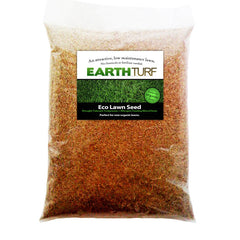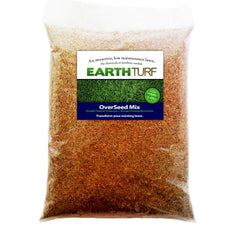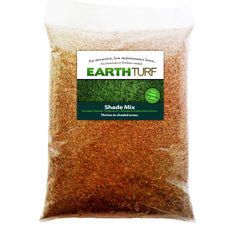A Visit To The Seed Research Station
The great traits in our grasses and clover - drought tolerance, dwarf growing, needing minimal fertilizer, disease resistance, beautiful color, and more... are improved over time through hard and tedious work at our seed research station near Oregon State University.
Proudly, none of our grasses are, or ever will be, genetically modified. They are selectively bred - the practice perfected by humans over thousands of years to breed plants for certain traits like higher yielding wheat, delicious tomatoes, and beautiful flowers.
Improved seed varieties take about 10 years to develop - a very slow process... But a very important one, as the better the grasses can be without the need for irrigation, fertilizer and maintenance - the easier it will be for people to adopt sustainable lawn care.

Rows of candidate grasses.
In the breeding process, one variety of seed is planted multiple times and each comes up slightly different. The best performing (maybe 1 or 2 out of 100) are selected, their seeds are collected, replanted, and the cycle continues.
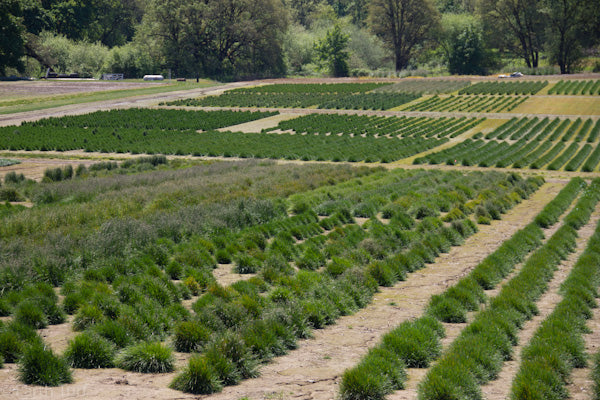
Kentucky Blue, Perennial rye, Tall fescue, Hard fescue, Creeping Red fescue, Chewings fescue, Sheeps fescue, Bentgrass and more... And there are hundreds of cultivars of each.

To prevent the fine fescues from cross pollinating, tall grasses are planted between each row to prevent pollen from spreading.

Its hard to see, but these rows each have different clover varieties. Clover is bred for many different purposes - forage type clover, used in animal pastures, is bred to be large, drought tolerant, nutrient rich, fixate nitrogen and grow fast.
Clover for lawns is bred much the opposite - to be as small as possible, durable, drought tolerant, work in a range of climates, and grow well alongside turf grasses.
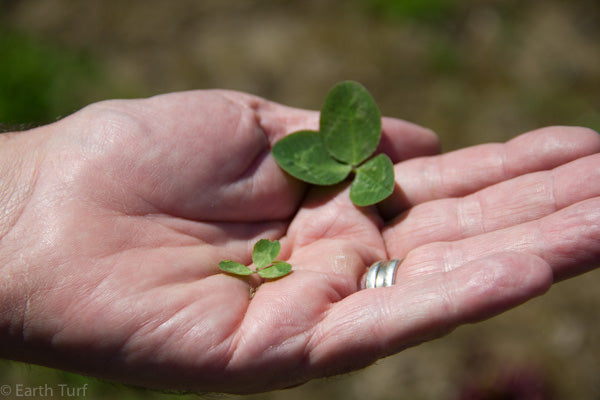
Small MicroClover next to a large forage type clover.

Not for your wet swim trunks - this seed cleaner separates seed from other parts of the plant.

Dr. Brad Jeffreys talking about the different seeds are stored in the lab. Its no easy task managing thousands of different seed varieties, just ask our friends in Norway.
Earth Turf featured in Cleveland's biggest newspaper
Earth Turf was featured in the Plain Dealer, Ohio's biggest newspaper.
"It's tough changing minds that clover isn't a weed," says Casey Hopkins, Earth Turf's founder. "But when you can have a lawn that looks great with minimal water and no chemicals, that old thinking goes out the door quickly."
Microclover-grass blends make for eco-friendly lawns by Roxanne Washington
Enjoy Clover Tea From Your Organic Lawn

A delicious benefit from a chemical free lawn – organic clover herbal tea.
Pour a cup of near boiling water over a 1/4 cup of rinsed fresh clover flowers, or 2 teaspoons of dried, and let steep for 5 minutes. Strain and enjoy. You can sweeten with honey or fresh lemon juice.
While we make no claims about clover’s remedial abilities (and are skeptical), it has long been used for helping to cure coughs, clear sinuses, bronchitis, pre-menstrual syndrome, an anti-inflammatory, helps with arthritis and gout, and as an anti-cancer treatment. It is applied topically to treat psoriasis. Not recommended with anyone pregnant as it has high levels of phytoestrogens which may affect estrogen levels.
The whole clover plant is actually edible and high in protein. Young clover leaves are good in a salad and roots and older leaves can be boiled to remove bitterness. Flour can be made with dried, ground flower buds. Dried clover leaves can impart a vanilla flavor if mixed into cake and baked goods.
We hear dandelions are delicious too. Seems what many people call weeds are the most beneficial parts of a lawn.
6 Best Tips For An Organic Lawn

1. Embrace a non perfect lawn
The most important step is to change your mindset. A flawless, bright green, closely cropped lawn would never appear in nature. And attaining this perfect lawn takes a lot of time, fertilizer and chemicals, tons of water and frequent mowing. An organic lawn may have a few imperfections, but view this as a beautiful sign your lawn doesn’t rob the environment or expose people to chemicals.
Perfect lawns are much like the food we have eaten for the past half century – bleached white flour, corn syrup, artificial sweeteners and synthetic preservatives – all have made our food taste, last and look better, but their negatives effects are coming to light and consumers are making changes.
“A weed is a plant whose virtues have not yet been discovered” -Ralph Waldo Emerson
2. Leave the grass clippings
They will naturally breakdown and add nutrients to the lawn.
3. If you Water, do it less often, but soak deep
Your lawn will not work harder than it has too. If you water often, the roots will only grow a few inches deep. Watering less often, but soak the soil deep, the roots will be encouraged to grow deep, where more water can be absorbed. Plus, there will be less evaporation.
4. Make your own organic weed killer
Pour a little soap in a bottle of vinegar and voilà – organic weed killer. For weeds growing from sidewalk cracks, boiling water will do the job.
5. Mow taller
Taller grass tends to prevent weeds from growing. It also keeps the soil from drying out.
6. Plant Earth Turf!
Start with the right seed. Earth Turf lets you enjoy a self fertilizing lawn that looks better than normal lawns under organic care.
Water Quality Goes Up After Lawn Fertilizer Ban, Study Shows
A new study from the University of Michigan shows that phosphorus levels in the Huron River dropped an average of 28 percent after Ann Arbor adopted an ordinance in 2006 that curtailed the use of phosphorus fertilizers on lawns.
 “It’s one of those things where political organizations take the action because they believe it’s the environmentally conscious thing to do, but there’s been no evidence offered in peer-reviewed literature that these ordinances actually have a salutary effect,” Says John Lehman, professor of ecology and evolutionary biology at the University of Michigan.
“It’s one of those things where political organizations take the action because they believe it’s the environmentally conscious thing to do, but there’s been no evidence offered in peer-reviewed literature that these ordinances actually have a salutary effect,” Says John Lehman, professor of ecology and evolutionary biology at the University of Michigan.
Now the evidence exists, though public education efforts and general increased environmental awareness among Ann Arbor residents could also be a factor.
Phosphorus, an essential plant nutrient, is found in every living cell, plant and animal. It makes a very green lawn and is common in store bought synthetic lawn fertilizer, but the fertilizer if often applied in too high of doses and seeps to ground water – causing algae blooms and killing fish.
“Although the science wasn’t difficult, its ramifications in a political sense and in an environmental sense will not be insignificant,” Lehman said.
The full article is here.
New York Times Endorses Clover Lawns In 1912!
Thought clover in lawns was a trendy new phenomenon?
This near century old clip from the New York Times shows clover in lawns was just as innovative then as it now.

Before herbicides and synthetic fertilizers came on the market in the 1950s, clover was a highly desirable component in lawns. Looks like we are coming back full circle now.
Thanks to GreensboroBirds.com for the link.
New York Times Archive
New Pesticide Documentary - A Chemical Reaction
A Chemical Reaction documents the Canadien town of Hudson’s hard fought battle to ban the use of all chemical pesticides and herbicides.

The most powerful chemical companies in North America put their full legal weight on the tiny town and eventually the case made it to the Supreme Court.
The town’s right to protect its citizens was upheld, and — like a row of dominos — other municipalities followed suit. The movement spread so far and wide that the entire province of Quebec enacted a ban and Home Depot stopped putting the dangerous pesticide products on their shelves.
The movie also features Paul Tukey who, after becoming seriously ill from applying chemical lawn products in his own lawn care business, has became a leading advocate for alternatives to chemical lawn care. The organization he started, safelawns.org, leads the push for environmental lawn care in North America. We also highly recommend his book, The Organic Lawn Care Manual – get a signed copy here. His blog is frequently updated too.
A Chemical Reaction was produced by PFZ Media and they are looking for donations to help finish the film and spread the word.
Solar Robotic Mower Makes For A No Maintenance Lawn
The new Husqvarna AutoMower Solar Hybrid is the world’s first robotic lawn mower powered by the sun. Paired with a low maintenance Earth Turf eco lawn, one can truly have a zero maintenance lawn.

The mower can handle large areas – up to 23,000sf (0.65 acre) and is equipped with an 18V NiMH battery. A wire staked beneath grass level around the lawn perimeter keeps the Automower in the mowing area.
Similar to popular Roomba vacuum cleaners, if the machine bumps into an obstacle, it reverses and heads in a different direction. And if power is low, the Automower returns to its base for recharging. The 22 pound mower also features a 4 digit pin code and a security alarm in case the neighbors decide they want to swipe it.
Earth Turf lawn seed, needing no fertilizer or chemicals and little or no irrigated water, is the perfect companion for this autonomous mower. Homeowners can now have a beautiful and naturally green lawn that stays perfectly cut – with no time and effort and no harm to the environment that wasteful traditional lawns have.
Innovation comes at a price though, as the Automower goes for $2999.95.
Earth Turf vs Traditional Lawn - Cost Comparison
Americans spend $28+ billion annually on lawn maintenance. Planting Earth Turf not only alleviates the financial costs of traditional lawn care, but minimizes environmental costs too.
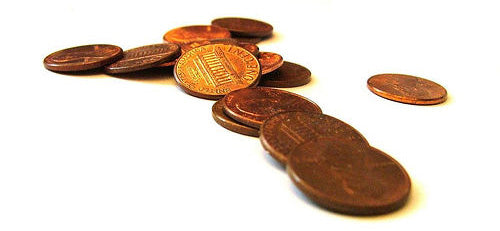
Earth Turf is planted just like a traditional lawn, so ground preparation and installation costs are equal. Earth Turf seed costs about $30 more than generic lawn seed for a 1000sf lawn, but by not having to install in-ground irrigation system, you can save thousands of dollars.
Annual Costs
Traditional lawns need about an inch of water per week, which is over 30,000 gallons per year for a 1000sf lawn. Fertilizer and weed control chemicals will run about $50 per year. Thatching and aeration is prescribed every two years for traditional lawns, while an Earth Turf Lawn can go without it.
Mowing requirements vary by geographic location and personal preference, but an average manicured traditional lawn receives 25-35 mows per year while an Earth Turf lawn can have less than 10. Or follow Google’s approach and eliminate lawnmowers altogether.
Environmental Costs
Traditional lawn maintenance wastes thousands of gallons of clean water for irrigation. Appearance improving synthetic fertilizer is derived straight from fossil fuels and can seep into ground water to cause algae blooms and ocean dead zones.
Unquantifiable Costs
With Earth Turf, you will never have children and pets playing on a fresh application of Weed & Feed. And with reduced maintenance, Earth Turf gives you more time for things more important than lawn care.
In short, self fertilizing Earth Turf saves you hundreds of dollars per year in maintenance, relieves a traditional lawn’s toll on the environment, does not expose your family to chemicals and saves many hours of work.
About Nitrogen Fertilizer
Americans apply thousands of tons of nitrogen fertilizer to beautify their lawns every year. This makes for greener landscapes, but comes at the cost of contaminating ground water, is a product of fossil fuels, and is plainly no longer needed.

Unsustainable
Almost all nitrogen fertilizer is made synthetically from methane through the Haber-Bosch industrial process. 70%-90% of fertilizer’s manufacturing cost is from this fossil fuel and is why fertilizer prices fluctuate with gas prices. Over half the nitrogen used in America has to be imported from oil producing countries.
Acute Application
Fertilizer is applied in one-time high doses rather than slowly over time. This leads to the intended plants not absorbing all of the nutrients and fertilizer seeping into the ground water.
Algae Blooms
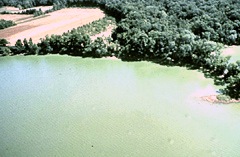
Nitrogen fertilizers are highly soluble and leach an unnaturally high amount of nitrates into the ground water. Nitrate-enriched groundwater makes its way into lakes, bays and oceans where it accelerates the growth of algae, disrupts the normal functioning of water ecosystems, and kills fish in a process called eutrophication (which may cause water to become cloudy and/or discolored—green, yellow, brown, or red). About half of all the lakes in the United States are now eutrophic, while the number of oceanic dead zones near inhabited coastlines are increasing (wikipedia).
The dead zone in the Gulf of Mexico coming from the mouth of the The Mississippi River is thousands of square miles in size.
Needed For Lawns?
Lawns are mostly maintained and fertilized for purely ornamental purposes. Lawns don’t produce food and or have high utility like sports fields. As the world moves toward more sustainable practices, typical suburban lawns – high maintenance and heavily fertilized – may become a symbols of unnecessary waste and vanity.
Earth Turf is the answer to American’s addiction to high maintenance traditional lawns. With nitrogen fixing MicroClover, Earth Turf can slowly and naturally feed itself and stay attractive without fertilizer and other chemicals – a green lawn without the negative ecological effects.
Learn more —
The Case Against Synthetic Fertilizers, by Deborah K. Rich – Great article on the history of nitrogen fertilizer production and its effects today.
Wikipedia – Fertilizer
Wikipedia – Eutrophication
NASA images of the Gulf of Mexico dead zone.
Products
-
Earth Turf
The best eco-friendly lawn mix for new lawns. EarthTurf combines a variety of the best performing low-maintenance...
-
Earth Turf Overseed
Transforms your existing lawn to a self fertilizing and eco-friendly Earth Turf lawn. Earth Turf...
-
Earth Turf Shade
Special shade tolerant turfgrasses and revolutionary MicroClover make this the perfect mix for sustainable shady areas....
